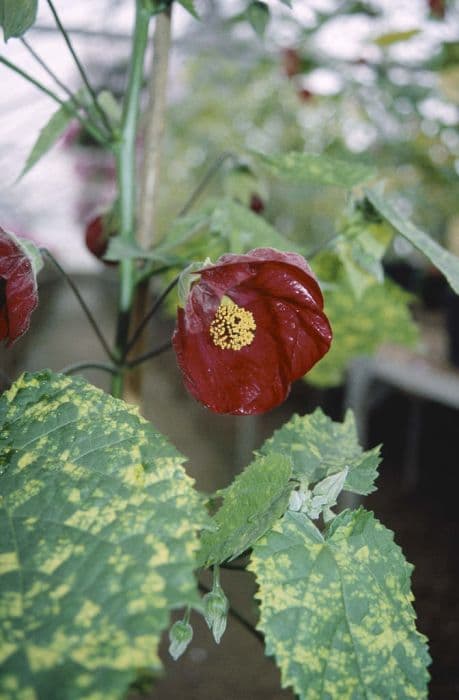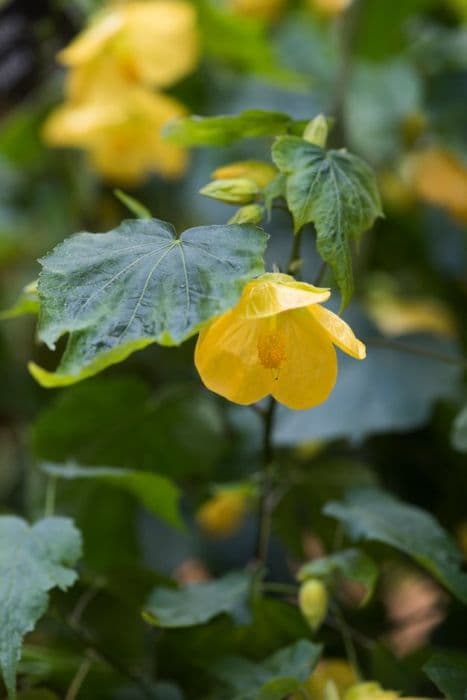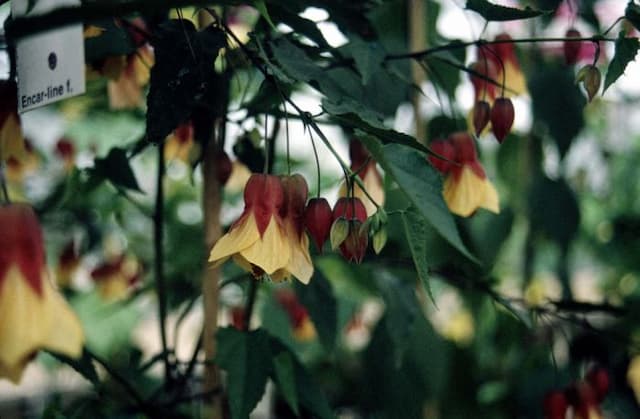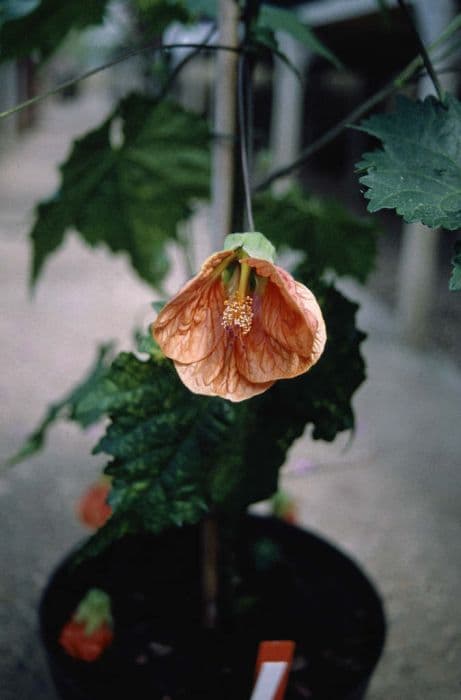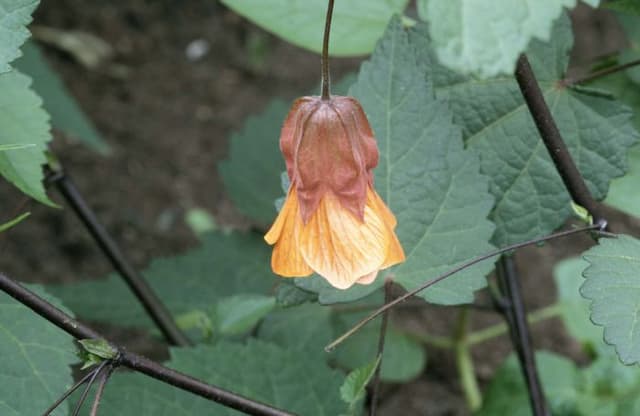Abutilon [Yellow Trumpet] Abutilon Yellow Trumpet = 'Oosttrump' (PBR)
![abutilon [Yellow Trumpet]](/_next/image?url=https%3A%2F%2Fplants-admin.emdemapps.com%2Fimages%2Fplants%2F%2Fimages%2F604b5caa8b4fb.png&w=3840&q=75)
ABOUT
is a semi-evergreen shrub to around 1.8m tall with dark green, lobed and toothed, maple-like leaves and nodding, trumpet to bell-shaped, bright yellow flowers borne from summer into early autumn
About this plant
 Names
NamesFamily
Malvaceae.
Synonyms
Flowering Maple, Abutilon Yellow Trumpet, Indian Mallow, Velvetleaf.
Common names
Abutilon 'Oosttrump'.
 Characteristics
CharacteristicsLife cycle
Perennials
Foliage type
Evergreen
Color of leaves
Green
Flower color
Yellow
Height
6-8 feet (1.8-2.4 meters)
Spread
3-4 feet (0.9-1.2 meters)
Plant type
Shrub
Hardiness zones
9
Native area
South America
Benefits
 General Benefits
General Benefits- Attractive Blooms: The Abutilon Yellow Trumpet produces showy yellow trumpet-shaped flowers that add a splash of color to gardens or indoor spaces.
- Extended Flowering Season: It has a long blooming period that can extend from spring to fall, providing sustained visual interest.
- Pollinator Friendly: The nectar-rich blooms are attractive to bees, butterflies, and other pollinators, encouraging biodiversity.
- Easy to Grow: This plant is known for being easy to care for, making it a good choice for both novice and experienced gardeners.
- Versatile: It can be grown in containers or planted in the ground, allowing flexibility in landscaping and garden design.
- Aesthetic Versatility: The Abutilon Yellow Trumpet can be used in a variety of garden styles, from tropical to cottage gardens.
- Fast Growing: It grows relatively quickly, providing rapid coverage or filling in garden spaces efficiently.
- Low Maintenance: Once established, it requires minimal care beyond watering and occasional pruning to maintain shape and health.
 Medical Properties
Medical PropertiesThis plant is not used for medical purposes.
 Air-purifying Qualities
Air-purifying QualitiesThis plant is not specifically known for air purifying qualities.
 Other Uses
Other Uses- Abutilon Yellow Trumpet can be used as a natural dye source for fabrics or paper, yielding yellow or green shades depending on the mordant used.
- The plant's fibrous stems can be processed to create a jute-like material suitable for crafting ropes or coarse textiles.
- The nectar-rich flowers can be a food source for hummingbirds and other nectar-feeding birds in a wildlife garden setup.
- Beekeepers may utilize Abutilon Yellow Trumpet as a forage plant to help sustain bee populations and support honey production.
- When dried, the flowers can be incorporated into potpourris or aromatic sachets for their subtle scent and visual appeal.
- Leaves of the plant can sometimes be used as a natural wrapping for foods in cooking practices, akin to grape leaves.
- The Abutilon Yellow Trumpet can be used in sound barrier hedges within urban areas, thanks to its dense foliage.
- Pressed and preserved Abutilon flowers may serve as decorative elements in scrapbooking or traditional herbarium collections.
- Its stems and leaves can be composted and returned to the garden as a nutrient-rich soil amendment.
- Innovative use in art installations or live walls can be an approach where the plant's growth pattern and vibrant flowers create a living piece of art.
Interesting Facts
 Feng Shui
Feng ShuiThe Flowering Maple is not used in Feng Shui practice.
 Zodiac Sign Compitability
Zodiac Sign CompitabilityThe Flowering Maple is not used in astrology practice.
 Plant Symbolism
Plant Symbolism- Beauty and Uniqueness: The 'Oosttrump' or Yellow Trumpet's vibrant yellow blooms and trumpet shape can symbolize the beauty and uniqueness in life, reflecting how individuality should be celebrated.
- Energy and Positivity: Yellow, being a bright and cheerful color, is often associated with positivity and energy. The Yellow Trumpet can represent an uplifting spirit and the power of positive thinking.
- Comfort: This plant can symbolize comfort and solace, as gardens and plants often provide a sanctuary for people to relax and find peace.
- Warmth: Similar to the sun, the Yellow Trumpet's warm color may symbolize warmth of feeling, friendship, and the presence of life's vibrant energy.
 Water
WaterFor the Flowering Maple, which is the common name for Abutilon 'Yellow Trumpet', maintain consistent moisture by watering when the top inch of the soil feels dry to the touch, typically once a week. In warmer months or in a particularly dry atmosphere, it might require watering twice a week. Depending on the pot size and environmental conditions, use about 16-32 ounces of water per watering session, ensuring you water deeply enough so that the water runs through the drainage holes. Reduce watering in the winter months when plant growth typically slows down. Always allow excess water to drain away to avoid waterlogged soil, which can lead to root rot.
 Light
LightThe Flowering Maple thrives in bright, indirect sunlight and should be placed in a location where it receives this light for most of the day. An east-facing or west-facing window is ideal, providing a few hours of gentle morning or afternoon sun. However, protect the plant from the harsh afternoon sun to prevent scorching of the leaves.
 Temperature
TemperatureThe ideal temperature conditions for the Flowering Maple are between 60 to 75 degrees Fahrenheit. This plant can tolerate a minimum temperature of around 50 degrees Fahrenheit and a maximum temperature of up to 85 degrees Fahrenheit. Sudden temperature fluctuations and cold drafts should be avoided to keep the plant healthy.
 Pruning
PruningPrune the Flowering Maple to maintain its shape and encourage bushier growth; doing so in the early spring before new growth begins is usually best. Cut back any leggy or dead stems, and remove spent flowers to promote continuous blooming. Pruning may be done every few months, as needed, to remove dead or yellowing leaves.
 Cleaning
CleaningAs needed
 Soil
SoilFlowering Maple prefers well-draining soil rich in organic matter with a slightly acidic to neutral pH between 5.5 and 7.5. A mix of two parts peat moss, one part loamy soil, and one part perlite or sand works well.
 Repotting
RepottingFlowering Maples should be repotted every 2 to 3 years in spring or as they outgrow their pots to prevent them from becoming root-bound and to refresh the soil.
 Humidity & Misting
Humidity & MistingFlowering Maple thrives in moderate to high humidity levels, ideally between 50% and 60%, because it is similar to their natural tropical habitat.
 Suitable locations
Suitable locationsIndoor
Place in bright, indirect sunlight and keep soil moist.
Outdoor
Needs partial shade and shelter from strong winds.
 Life cycle
Life cycleThe Abutilon Yellow Trumpet, also known as the Flowering Maple, begins its life cycle as a seed, which when sown in well-draining soil and provided with warmth, will germinate. After germination, the seedling stage involves the growth of primary leaves and establishment of a root system. As the plant matures into the vegetative stage, it develops a woody stem and maple-like leaves, and under adequate light, temperature, and moisture conditions, it enters the flowering stage, producing bell-shaped yellow flowers that attract pollinators. Following pollination, the plant may set seed within fruit-like capsules, completing the cycle of reproduction. The Abutilon Yellow Trumpet can remain in the flowering stage for an extended period, especially in regions with mild temperatures, where it can become a perennial shrub. In colder areas, it is often grown as an annual and needs to be replanted each year or overwintered indoors.
 Propogation
PropogationPropogation time
Spring-Early Summer
The Abutilon Yellow Trumpet, commonly known as the flowering maple, is typically propagated through stem cuttings. This popular method involves taking a healthy, non-flowering stem from the parent plant during the active growing season, which is usually spring or early summer. Cut a 4-6 inch (10-15 cm) section of the stem, ensuring there are at least two sets of leaves. Remove the bottom leaves and dip the cut end into a rooting hormone powder to encourage root growth. The cutting is then placed in a well-draining potting mix, with the bottom half of the stem buried. It's important to maintain a warm, humid environment for the cutting, which can be aided by covering the pot with a plastic bag or placing it in a propagator. Rooting typically occurs within a few weeks, after which the new plant can be gradually acclimated to less humid conditions before transplanting.
